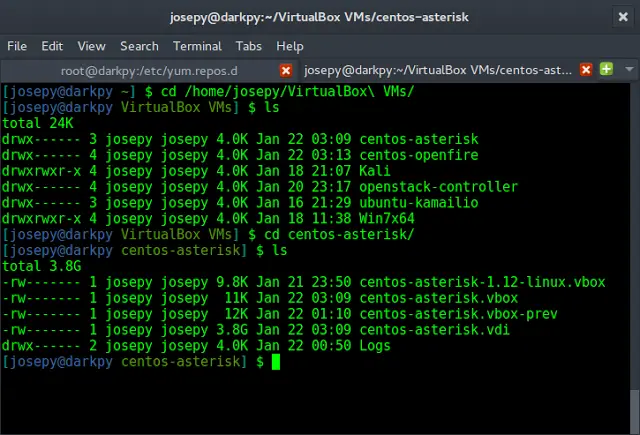Vagrant is one of the favorite tools for Developers. Vagrant is a tool designed to enable users create and configure lightweight, reproducible, and portable development environments with the Virtualization environments of their choice – VirtualBox, KVM, VMware e.t.c. So how can I use Ansible with Vagrant for clean automation?.
You can use Ansible with Vagrant to automate provisioning of Vagrant machines requirements and setup software dependencies. This guide won’t go into so much detail about Vagrant and Ansible, but just an overview on how you can use Ansible with Vagrant.
I’ll a create a project directory.
mkdir ~/myvagrant
cd ~/myvagrantI’ll create a Simple Ansible Playbook to update the OS and install basic packages. You can extend to cover what you need to setup.
$ vim provision.yaml
---
- hosts: all
become: yes
become_method: sudo
tasks:
- name: Update OS
package:
name: '*'
state: latest
- name: Install Basic packages
package:
name: ['vim', 'zip', 'bash-completion', 'wget', 'tmux']
Then create a Vagrantfile with a definition of ansible provisioner.
$ vim Vagrantfile
# -*- mode: ruby -*-
# vi: set ft=ruby :
ENV['VAGRANT_DEFAULT_PROVIDER'] = 'libvirt'
Vagrant.configure("2") do |config|
##### VM definition #####
config.vm.define "rocky" do |config|
config.vm.hostname = "rocky"
config.vm.box = "bento/rockylinux-8 "
config.vm.box_check_update = false
config.vm.provision :ansible do |ansible|
ansible.limit = "all"
ansible.playbook = "provision.yaml"
end
config.vm.provider :libvirt do |v|
v.memory = 1024
v.cpus = 1
end
end
endAs can be seen in our Vagrantfile, we’re using provision.yaml Playbook.
Once you have both Playbook and Vagrantfile ready, run the vagrant up command to start the Virtual Machine.
$ vagrant up
Bringing machine 'cent01' up with 'libvirt' provider...
==> cent01: Box 'centos/8' could not be found. Attempting to find and install...
cent01: Box Provider: libvirt
cent01: Box Version: >= 0
==> cent01: Loading metadata for box 'centos/8'
cent01: URL: https://vagrantcloud.com/centos/8
==> cent01: Adding box 'centos/8' (v1905.1) for provider: libvirt
cent01: Downloading: https://vagrantcloud.com/centos/boxes/8/versions/1905.1/providers/libvirt.box
cent01: Download redirected to host: cloud.centos.org
cent01: Calculating and comparing box checksum...
==> cent01: Successfully added box 'centos/8' (v1905.1) for 'libvirt'!
==> cent01: Uploading base box image as volume into libvirt storage...
==> cent01: Creating image (snapshot of base box volume).
==> cent01: Creating domain with the following settings...
==> cent01: -- Name: cent8_cent01
==> cent01: -- Domain type: kvm
==> cent01: -- Cpus: 2
==> cent01: -- Feature: acpi
==> cent01: -- Feature: apic
==> cent01: -- Feature: pae
==> cent01: -- Memory: 1024M
==> cent01: -- Management MAC:
==> cent01: -- Loader:
==> cent01: -- Nvram:
==> cent01: -- Base box: centos/8
==> cent01: -- Storage pool: default
==> cent01: -- Image: /var/home/jkmutai/.local/share/libvirt/images/cent8_cent01.img (11G)
==> cent01: -- Volume Cache: default
==> cent01: -- Kernel:
==> cent01: -- Initrd:
==> cent01: -- Graphics Type: vnc
==> cent01: -- Graphics Port: -1
==> cent01: -- Graphics IP: 127.0.0.1
==> cent01: -- Graphics Password: Not defined
==> cent01: -- Video Type: cirrus
==> cent01: -- Video VRAM: 9216
==> cent01: -- Sound Type:
==> cent01: -- Keymap: en-us
==> cent01: -- TPM Path:
==> cent01: -- INPUT: type=mouse, bus=ps2
==> cent01: Creating shared folders metadata...
==> cent01: Starting domain.
==> cent01: Waiting for domain to get an IP address...
==> cent01: Waiting for SSH to become available...
cent01:
cent01: Vagrant insecure key detected. Vagrant will automatically replace
cent01: this with a newly generated keypair for better security.
cent01:
cent01: Inserting generated public key within guest...
cent01: Removing insecure key from the guest if it's present...
cent01: Key inserted! Disconnecting and reconnecting using new SSH key...
==> cent01: Setting hostname...
==> cent01: Configuring and enabling network interfaces...
cent01: SSH address: 192.168.122.48:22
cent01: SSH username: vagrant
cent01: SSH auth method: private key
==> cent01: Rsyncing folder: /var/home/jkmutai/myhacks/vagrant/cent8/ => /vagrant
==> cent01: Running provisioner: ansible...
Vagrant has automatically selected the compatibility mode '2.0'
according to the Ansible version installed (2.9.5).
Alternatively, the compatibility mode can be specified in your Vagrantfile:
https://www.vagrantup.com/docs/provisioning/ansible_common.html#compatibility_mode
cent01: Running ansible-playbook...
PLAY [all] *********************************************************************
TASK [Gathering Facts] *********************************************************
ok: [cent01]
TASK [Update OS] ************************************************
changed: [cent01]
TASK [Install Basic packages] ************************************************
changed: [cent01]
PLAY RECAP *********************************************************************
cent01 : ok=2 changed=1 unreachable=0 failed=0 skipped=0 rescued=0 ignored=0
If you had your Vagrant machine up, then use the command:
vagrant provisionOur execution was successful, you can now ssh to the VM with the command:
$ vagrant sshRead through the Vagrant Provisioning guide to learn more about supported provisioners and how to use them.
More guides:
Enable Hyper-V and Install Vagrant on Windows
How To Install Vagrant on CentOS 8 / RHEL 8
Run CentOS 8 VM using Vagrant on KVM / VirtualBox / VMWare / Parallels




